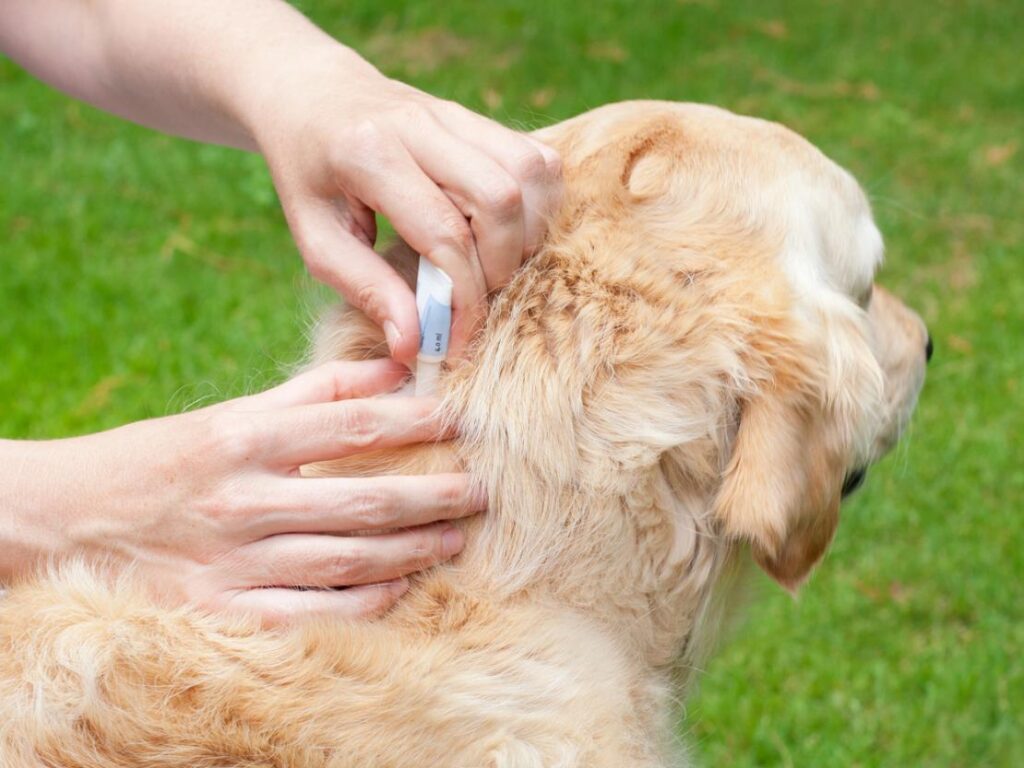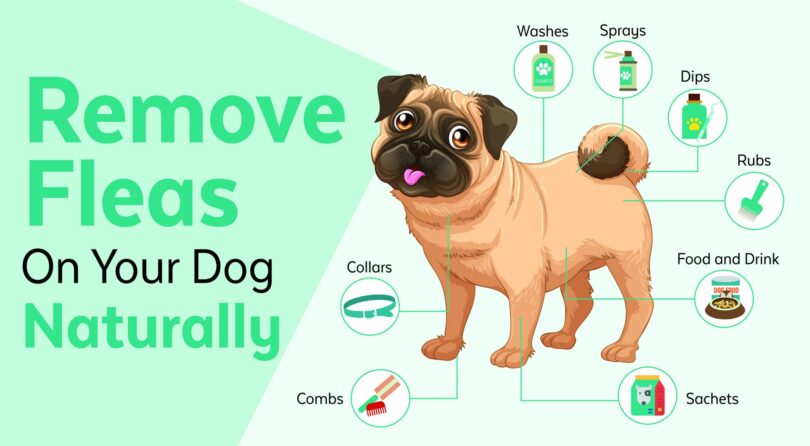If you’ve ever found fleas on your dog, you’ve experienced that feeling of sheer horror as you watch those little specks scurry to safety in your dog’s fur. What’s the first thing you do? You look up, how to get rid of fleas on dogs! Luckily you have arrived at the most complete and best flea treatment for dogs guide out there.

Quick, while she is not looking!
Fleas are very common in dogs in the southern and eastern parts of the country, and most dogs there are on a flea preventative medication. A serious flea infestation–both on your dog and in your home–can be incredibly difficult to get rid of, so prevention is key. If your dog and home have fallen victim to a flea infestation, you can take back your home and pet with some of the methods mentioned in this article.
But before we do let’s go over few of the more frequently asked questions:
Does pet insurance cover flea treatment?
Yes and no. Some do via a rewards program, which also cover other preventative care treatments. We use PetPrimium as its the most affordable options and has an inexpensive allowance program for general pet care services like flea removal. You are better of with a vet care discount plan as that gives you an on the spot 25% price reduction on all vet bill without approvals or claim forms to fill.
Do Fleas Carry Diseases?
Fleas may seem fairly harmless, but the fact remains that they do carry diseases, and those diseases can be very dangerous to your family. The most common flea-carried disease is Yersenia pestis, also known as the plague. A flea that has fed on an infected animal (like a rat, prairie dog, or chipmunk) and then somehow winds up on your dog or cat introduces it into them. The plague is a bacterial disease, so if it’s caught, it is treatable. Dogs can become infected with the bacteria and pass it on to your family. This stresses the importance of a good flea preventative. If fleas steer clear of your dog, they won’t be exposed to the bacteria.
Not All Flea Preventatives and Treatments Are Created Equal!
There are a lot of products on the market that aren’t effective and can actually be deadly to your dog. Flea collars are marketed as good for both preventing and treating fleas, but they’re both useless and dangerous. The Natural Resources Defense Council (NRDC) has categorized flea collars as a level II poisonous substance to dogs. Their report stated that even if flea collars are used as directed, they can still cause a variety of serious health issues in animals, including neurological symptoms and death. The pesticides used in the collars are also dangerous to humans, especially children. The chemical residue remains on the animal’s fur for weeks, giving near constant exposure to your children. Under no circumstances should you ever use a flea collar. There are far better options that will work and not slowly poison your entire family!
Contents
Safe and Effective Ways to Get Rid of Fleas on Your Dog
Monthly Flea Preventative
You can get flea preventative at your veterinarian or over the counter at pet supply or feed stores. The popular brands like Frontline, K9 Advantage, and Revolution are topical medications that are applied once a month. You squirt the medication onto their skin between their shoulders and it’s slowly absorbed by the skin to provide full body protection.
The beauty of these topicals is they not only prevent flea infestations, they also kill any fleas currently on your dog. If you’ve gotten a dog from a shelter and they’re infested with fleas, you can apply a topical preventative and see a drastic improvement or complete elimination of fleas within 24 hours.
Be cautious when purchasing these monthly topicals in stores. There are many brands that are significantly cheaper than the trusted brands like Frontline or Advantix. While the cost savings might be attractive, it’s not worth it. There have been many reported cases of dogs suffering seizures, organ damage, and even death with these cheaper alternatives. Stick with brands made by trusted veterinary medical supply companies and ask your veterinarian what’s considered safe and what should be avoided.
Flea Sprays
You can purchase flea sprays in the store or from your veterinarian. They don’t work as well as topical monthly applications, but they can do the job in a pinch or until you can get to your vet for a better treatment option. You should always follow your vet’s recommendation for how often you should apply the spray. Too much of the spray can burn your dog’s skin or overload their bodies with pesticides and chemicals, which can then lead to other problems. Less is always more, but don’t expect to see too much of an improvement if your dog has a major infestation. The sprays definitely work better on minor infestations.
Flea Shampoos
Shampoos don’t have any residual activity, so they shouldn’t be used as a way to prevent flea infestations. If you think giving your dog occasional baths in a flea shampoo will prevent infestations, you’re wrong. The shampoos are designed to rid your dog of minor flea infestations. It’s easy enough to use, too. You get your dog wet and then lather them up with the recommended amount of shampoo. Using more won’t make it more effective! Follow the directions exactly, so if the label says leave it on for ten minutes, leave it on for ten minutes. Avoid making contact with your dog’s eyes, genitals, and ears. Putting a thin layer of petroleum jelly around the eyes will prevent the shampoo from running into them.
Flea Dips
Dips aren’t commonly used anymore to treat fleas. Some vets use them as a last resort in very severe infestations where they just can’t rid of the pesky little bugs. It’s not very likely that your vet will send the dip home with you because of the importance in following the manufacturer’s directions. They have to be applied in very well ventilated areas for both you and your dog’s sake. It’s imperative the dip doesn’t get into your dog’s eyes and ears or around mucus membranes. Finally, depending on the dip, it does have to be left on for a certain period of time. This can be hard to do at home where you don’t have the facilities to keep your dog confined in an area that’s well-ventilated. Your cat can’t come into contact with these dips either because most of them contain pyrethrins and permethrins, both of which are deadly to cats.
Oral/Injectable Medications
Some homes just aren’t suitable for topical drugs, especially homes with cats and very small children. In this case, your vet might be able to prescribe oral or injectable drugs to eliminate and prevent fleas. Tablets are given every month (much like heartworm preventative) and the injections are given every six months. Program is the most common tablet on the market, but it doesn’t kill adult fleas, meaning you’ll have to use an alternative treatment if your dog has a current infestation. Capstar is an oral tablet that kills fleas but is eliminated from the system after 24 hours. It kills adult fleas, but will still need to be followed up with a drug that kills the entire life-cycle of the flea. Trifexis is a heartworm preventative that prevents heartworm, kills fleas, and controls intestinal parasite infections.
Flea Combs
Flea combs are good when used in combination with medication. These combs have teeth that are designed to remove fleas. If you have a dog that’s too old, young, or ill to use medications, flea combs are completely safe. You simply comb your dog from head to toe and dip the comb in detergent water to kill the fleas.
Treating Fleas in the Home
Treating your dog is one thing, but getting them out of your home can be a different story. Many people have battled flea infestations for months before finally ridding their home of these tiny invaders.
Diatomaceous Earth
Diatomaceous earth is the fossilized remains of diatoms. It’s a very fine, white powder that’s actually great for killing fleas. The cell walls of diatoms are made of silica, which damages the shells of fleas and then dries them out, ultimately killing them. Diatomaceous earth is completely non-toxic to both pets and humans. First, vacuum your home thoroughly. When the floors are vacuumed, sprinkle the DE on the carpets. Leave it there for 12 to 48 hours; the longer it sits, the more effective it will be. Vacuum it up and immediately dispose of the vacuum bag.
Flea Traps
If you have a very small, minor infestation, you can make your own flea traps. Fill bowls with dishwashing liquid and warm water. Put a tea candle in the middle of each bowl and light the candle. The light will attract the fleas and the thickness of the soap will trap the fleas. It might seem like a bit of hocus pocus, but it’s quite effective in getting rid of small amounts of fleas.
Foggers
Foggers contain chemicals that kill the entire lifecycle of the flea, not just the adults, and prevent the development of pupae and eggs. You’ll need a fogger that contains an adulticide and an insect growth regulator. Foggers are great for open areas because they reach most cracks and surfaces. You shouldn’t use foggers if you have very small children, family members with asthma, or small animals like birds.
Professional Treatment
If you aren’t opposed to chemicals, then professional treatment is probably your best method of elimination. They know exactly what to use and how much to use to ensure your infestation problem is treated promptly and effectively. Most companies have customized solutions for how to treat your home, and the package often includes follow-up treatment. Their chemicals are very safe for both humans and animals in your house.
Fleas are a huge problem once they’ve invaded your dog and home, so the best step you can take is preventing them altogether. Following your vet’s recommendation for prevention will ensure you never have to worry about fleas in the carpet, in your bed, or crawling across your dog as you’re scratching their ears.
Want to supercharge your First Aid Skills? Watch this short video on a DIY approach where you can use white vinegar mixed with water and shampoo to get rid of them nasty fleas cheap:







